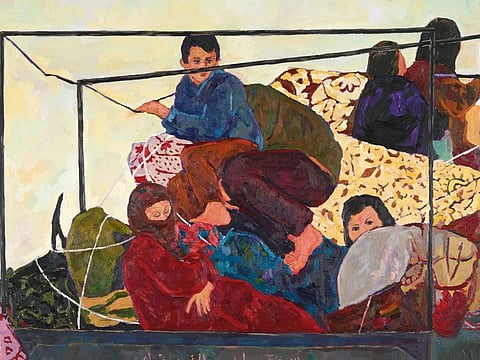Art Dubai: From contemporary galleries to digital artworks
Art Dubai’s latest iteration had something to satiate every palate

Amidst an increasingly crowded art calendar, one fair always holds its own. It’s Art Dubai that returned for its 15th edition in March, with studied diversity and an even-keeled tone as it brought to the fore over 100 exhibitors from 44 countries. It had the gravitas to pull crowds of eager visitors and collectors, who perused the fair’s web of connects that flecked the elaborate expanses of Madinat Jumeirah.
From a robust roster of modern and contemporary galleries to a new digital section to commissioned site-specific works, this iteration had something for everyone. One of its greatest curatorial hooks was Art Dubai Modern, led by Sam Bardaouil and Till Fellrath, who offered an expertly executed balancing act between Middle Eastern and North African works by 20th-century masters, including Anas Albraehe (Agial Art Gallery) and Chant Avedissian (Sabrina Amrani Gallery). “I was very excited about the Modern section of the fair this year,” says Hala Khayat, Regional Director of Art Dubai. “The undiscovered gems were drawn from the Middle East and North Africa to create a special section, with the aim of educating visitors on how art from this region has developed,” adds Hala.
The Modern section housed 11 presentations by creatives originating from a host of countries such as Egypt, India, Lebanon, and Morocco. “All the showcases this year had rich history and incredibly interesting stories to tell, and we were excited about sharing them with visitors, students and scholars, helping them understand and appreciate the richness of the regional art scene’s heritage and history,” Hala states.
The resulting curation offered visceral aesthetic seduction, from the asymmetrical equilibrium of Nabil Nahas’ Fractal se- ries to Shanti Dave’s mixed-media compositions. In addition to the gallery halls, the fair also hosted a series of Modern Talks between 10-12 March, in conjunction with the Dubai Collection. “The idea was to delve deeper into the academic context of these artworks, positioning Art Dubai not only as an ‘art’ fair, but also as an educational platform for scholarship. This platform is a gift to the whole region —it’s an important piece of history in the making.”
Another key focus for this year’s edition was a curated programme that combined visions of the past, present and future of Dubai, with a special nod to sustainability. As part of the en- deavour, Spanish artist-archaeologist Fernando Garcia-Dory and art collective INLAND created a new multi-site installation at the fair and across a number of locations in the city. Titled Sand Flow, the work examined the multiplicity of cultures and communities that inhabit the city and their contributions to it, offering a confluence of archaeology, hydrology, urbanism, transport, and Middle Eastern heritage.
“For Sand Flow, I looked closely at the city of Dubai to give me a deeper context,” shares Fernando. “But what really interested me about this vibrant city in the middle of the desert is how the economy is still evolving and has been since the Middle Ages— from its status of being a trade centre to a pearl producer, to an oil producer and now a global trade hub. It’s such a unique place and a melting pot of cultures.”
“If we look at Sand Flow from the perspective of sustainability, we developed the proposal after several encounters and conversations with Earthy, a Sharjah-based arts and crafts council promoting the exchange between craftspeople, artists, and designers. We then started to look at how techniques such as palm-tree weaving and earth building from premodern times were adapted in terms of user materials.”
The installation featured a slot car racing game as a gamification of reality, or a learning tool to help us stop and think about what’s around us. It was based on the concept of creating a space or portal to understand more about the flow of energy, time, and matter around Dubai. “Different characters raced across a city that’s partly growing and partly decaying, which referred to the cycles of growth and decay in the organic world,” explains Fernando. “The portal connected the player to different sites across the city to unlock different parts of the story.” Fernando says that he used many materials from the Art Dubai fair to create the installation, upcycling what was possible. “We’ll also some elements of the commission. The game that was on display, for example, will be donated to a refugee charity for children to play with.”
On the eco-conscious front, Art Dubai also featured the A.R.M. Holding Children’s Programme, a series of artist-led workshops focusing on sustainability for children aged between five and 17 years. They were led by Kenyan artist Cyrus Kabiru, who worked with the participants to retrieve and repurpose everyday mate- rials from their homes and schools to create works of art. The inaugural initiative will expand to take place in 80 schools, reaching more than 5,000 children across Dubai.
Art Dubai rounded off with the promise of returning with an even more scintillating fair next year. Until next time.
Sign up for the Daily Briefing
Get the latest news and updates straight to your inbox



